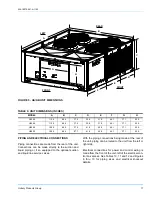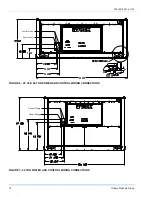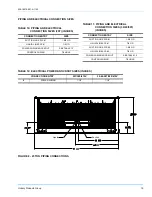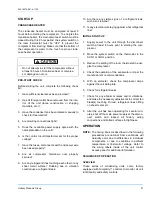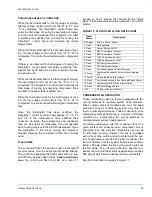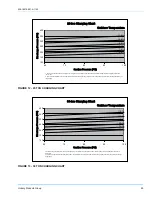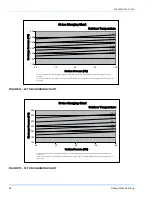
035-18575-001-A-1102
Unitary Products Group
11
NOTE: Always drill a small hole in sealing caps and
discs before unbrazing to prevent the pressure
in the line from blowing them off.
NOTE: Solenoid and hot gas bypass valves (if used)
should be opened manually or electrically dur-
ing brazing or evacuating.
The evaporator coil section is shipped with the side
panels suitable for right end piping connections when
viewed from the return air ends of the section.
Begin the refrigerant mains by installing the liquid line
from the condensing unit to the evaporator liquid con-
nection, maintaining a flow of nitrogen during all braz-
ing operations. The filter-drier and sight glass must be
located in this line, close to the evaporator. Make the
suction line connection at the evaporator and run the
line to the condensing unit.
For Units Without Service Valves - Reclaim the
refrigerant holding charge prior to opening any portion
of the system. Connect a low pressure Nitrogen source
to the suction and liquid line service ports on the con-
densing unit. Drill a small hole in the sealing disk; the
flow of Nitrogen will prevent any debris from entering
the system. Unbraze the sealing disk and prepare the
joint for connections of the main lines. Connect the
lines while maintaining a flow of Nitrogen from the liq-
uid line service port through the evaporator, back to the
condensing unit and out the suction service port.
For Units Equipped With Service Valves - Verify the
service valves are fully seated by screwing the stem
down into the valve body until it stops. Connect a low-
pressure nitrogen source to the service port on the
valve body. The flow of Nitrogen will prevent oxidation
of the copper lines during installation. Drill a small hole
in the sealing disk; the flow of Nitrogen will prevent any
debris from entering the system. Wrap the valve body
with a wet rag to prevent the valve body from overheat-
ing during the brazing process. Overheating the valve
will damage the valve seals. Ensure the valve is ade-
quately protected prior to any brazing on the valve
body. Unbraze the sealing disk and prepare the joint
for connections of the main lines. Connect the lines
while maintaining a flow of Nitrogen from the liquid line
valve service port through the evaporator, back to the
condensing unit and out the suction valve service port.
Once the brazing process is complete, leak testing
should be done on all interconnecting piping and the
evaporator before proper evacuation to 500 microns is
performed. Once the line set and evaporator section is
properly evacuated the service valves can be opened
and the condensing unit is now ready to charge with
the appropriate weight of refrigerant.
LINE SIZING
When sizing refrigerant pipe for a split-system air con-
ditioner, check the following:
1.
Suction line pressure drop due to friction.
2.
Liquid line pressure drop due to friction.
3.
Suction line velocity for oil return.
4.
Liquid line pressure drop due to vertical rise.
Tables 6 and 7 list friction losses for both the suc-
tion and liquid lines on the condensing section. For
certain piping arrangements, different sizes of suc-
tion line pipe may have to be used. The velocity of
the refrigerant vapor must always be great enough
to carry the oil back to the compressor.
Evaporator Below Condensing Section - On a split
system where the evaporator blower is located below
the condensing section, the suction line must be sized
for both pressure drop and for oil return. See Table 6.
Condensing Section Below Evaporator - When the
condensing section is located below the evaporator
blower, the liquid line must be designed for the pres-
sure drop due to both friction loss and vertical rise. See
Table 10. If the pressure drop due to vertical rise and
friction exceeds 40 psi, some refrigerant will flash
before it reaches the thermal expansion valve.
Flash gas:
1.
Increases the liquid line pressure loss due to fric-
tion that in turn causes further flashing.
2.
Reduces the capacity of the refrigerant control
device that starves the evaporator.
3.
Erodes the seat of the refrigerant control device.
4.
Causes erratic control of the refrigerant entering
the evaporator.
SERVICE VALVES
These condensing units may have service valves on
the compressor suction line and on the liquid line
leaving the condenser coil or if so equipped from the
factory, if chosen as an option.

















